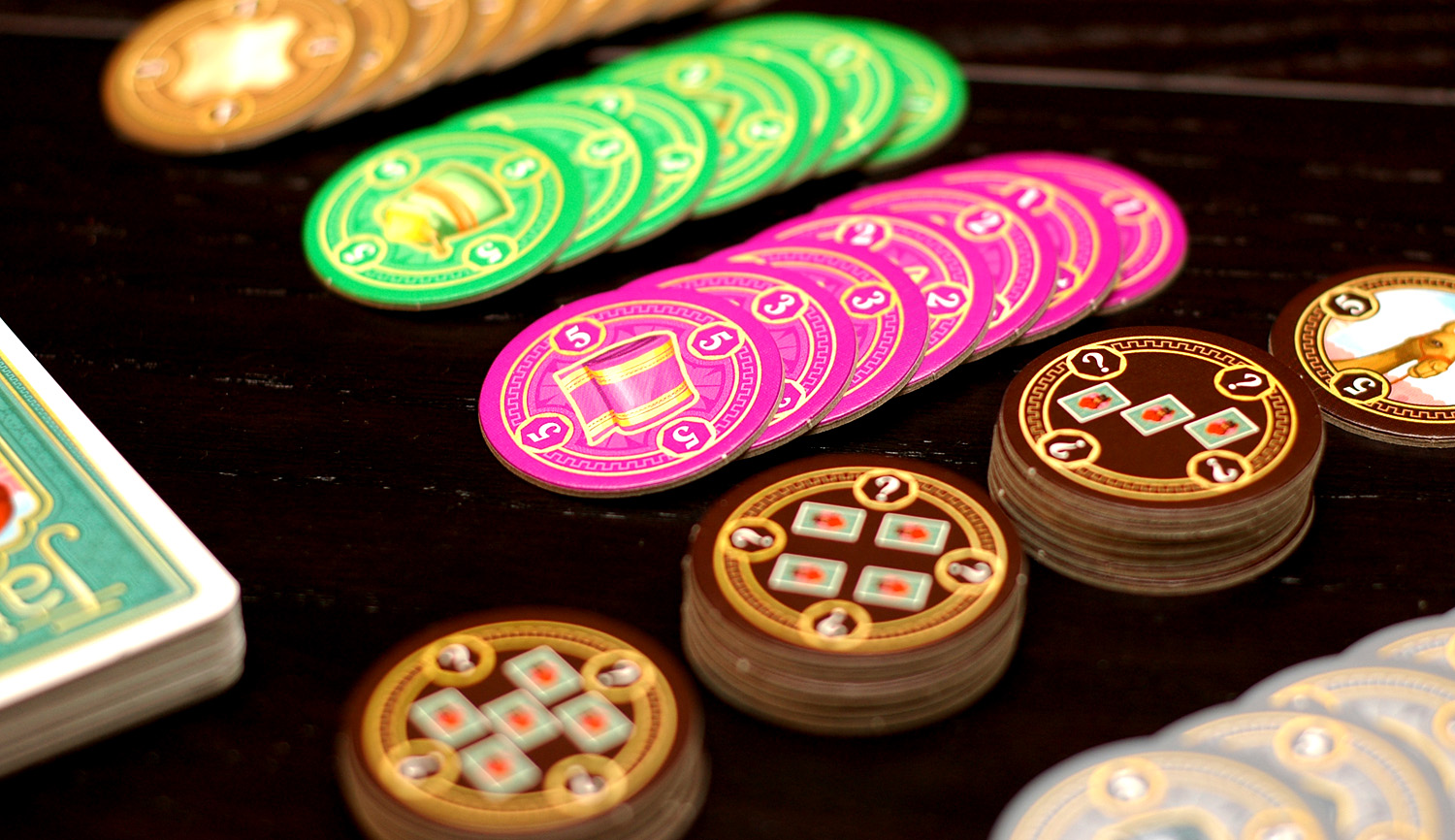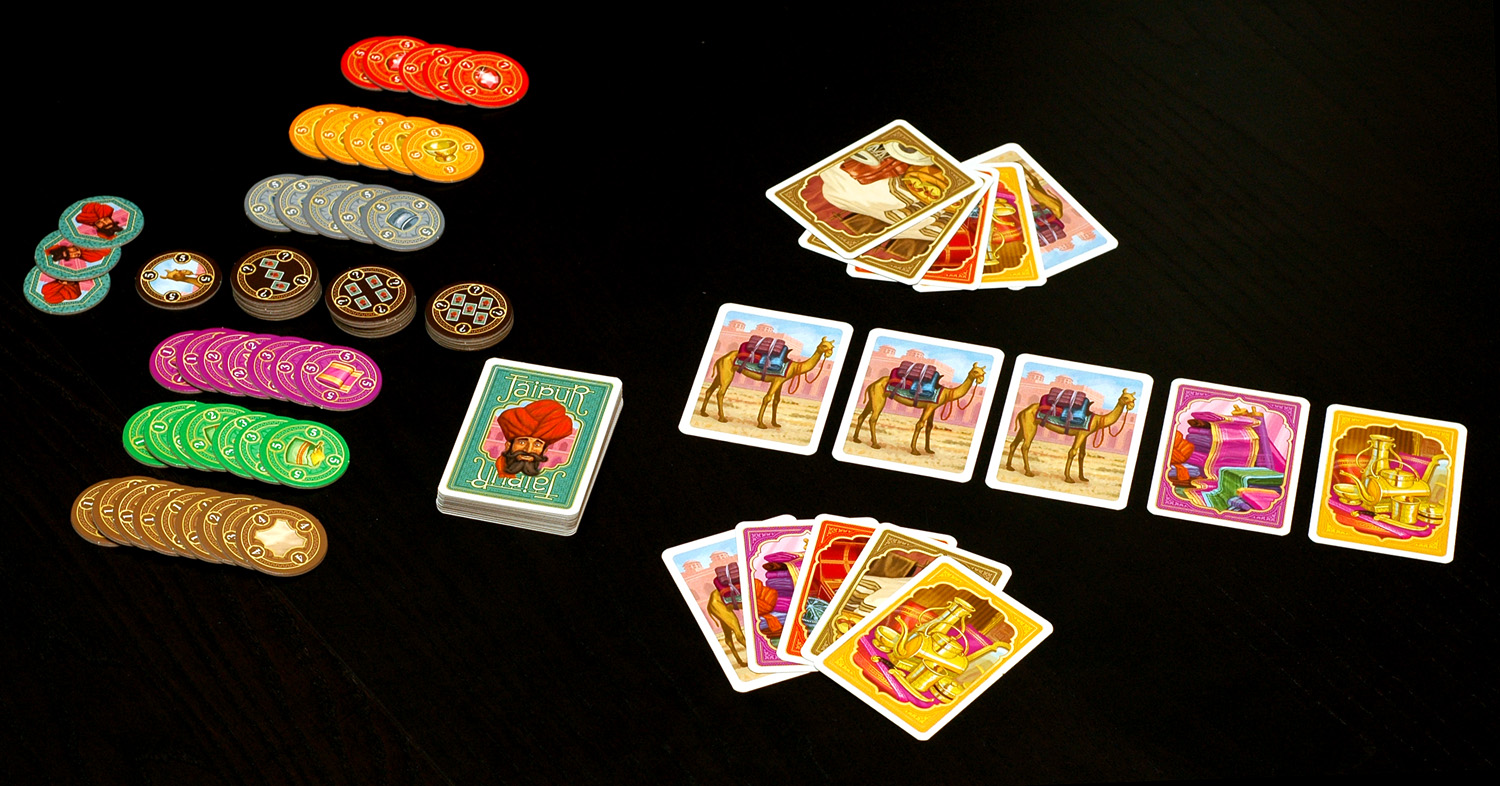Diamond in the Rough – A Jaipur Review
 The winding streets of the bustling center of goods and commerce in India are filled with row upon row of merchants selling, bartering and trading untold riches, from fine cloth to glittering gold. You quickly make your way around the stalls, dodging advances from a smug rug merchant, but are soon cornered by a shifty, rather persistent man, dressed all in white. With a gleam in his eye, he produces a large, rather garish diamond from his sleeve. “Rumor has it that this stone once fell from the heavens and into the lap of a young prince; it is priceless, but it is yours for a mere 200 rupees.” You wave him off with a hasty harumph; you’ve no time for this, and with a quick shout back over your shoulder you dismiss him: “Stuff it, bub – I’m here to see a man about a camel.”
The winding streets of the bustling center of goods and commerce in India are filled with row upon row of merchants selling, bartering and trading untold riches, from fine cloth to glittering gold. You quickly make your way around the stalls, dodging advances from a smug rug merchant, but are soon cornered by a shifty, rather persistent man, dressed all in white. With a gleam in his eye, he produces a large, rather garish diamond from his sleeve. “Rumor has it that this stone once fell from the heavens and into the lap of a young prince; it is priceless, but it is yours for a mere 200 rupees.” You wave him off with a hasty harumph; you’ve no time for this, and with a quick shout back over your shoulder you dismiss him: “Stuff it, bub – I’m here to see a man about a camel.”
And that’s Jaipur. Sort of.
Jaipur is a relatively simple card game of set collecting, patience and just a smidgen of luck. The overall goal of the game is to be the best trader after you’ve seen a whole week’s (round’s) worth of the Market’s wares. If you manage to get the best goods at the end of the round and sell them for the most rupees, you are awarded a seal of excellence. The first player to be awarded two seals becomes the Maharaja’s personal trader and wins the game!
To become the best trader, you have to survey and procure the best wares. There are several types of goods in Jaipur, represented by five cards that are revealed and always visible in the Market: diamonds, gold, silver, cloth, spice, leather, and the often-pesky camels. Diamonds, gold and silver are worth the most bonus rupees, but also have the fewest cards in the deck. The camels are the most common, and generally worth the least – however, the player who collects the most camels in a round wins a bonus. It’s paltry, but sometimes it can make all the difference in determining a winner!
Each round, a player can do one of two things: Take cards from the Market, or sell goods that the player already has in hand.

Goods tokens are taken from front to back... so punks can steal the good ones while you wait for a bonus set.
When players take cards from the Market they may either: Take one card, and replace that card with a card from the top of the deck; take several cards and replace each of those cards with cards they have in their hand; or take all the camels in the Market and replace those camels with cards from the top of the deck. Taking camels is risky as it may open good options for your opponent, but remember – he who has the most camels laughs last. Or something like that.
When players choose to sell goods in their hand, they place any number of goods of the same type in the discard pile. If the player sells three, four or five of the same goods at one time, the player also takes a corresponding bonus token. Each of these tokens are worth an unknown and random amount of rupees – determined on the back of the token – at the end of the round. The cheaper goods in the game can be sold off one at a time, but the more expensive goods – diamonds, gold and silver – may only be sold if the player discards two or more of them in the same round.
A round ends when three types of goods tokens are depleted. The players turn over their goods tokens, count the number of rupees on the back, and the richest player is awarded a seal of excellence. Oh, and don’t forget to count camels – that player gets the camel token, which is worth five rupees, and really can win the game! I told you they can be pesky.
| Gameplay/Replay | Components & Theme | Fun |
|---|---|---|
| Overall score: 16 out of 18 - Buy, sell, trade; beg, borrow or steal - you need Jaipur in your collection. | ||
Jaipur is a game for 2 master traders, ages 12 and up, by Sébastien Pauchon from GameWorks. It retails for $19.99 from Funagain Games, or you can pick it up from your favorite local game store.
![]() Did you know that when you buy from Funagain Games that you’re helping out this site? It’s true! Get games, help out your favorite blog. It’s win/win!
Did you know that when you buy from Funagain Games that you’re helping out this site? It’s true! Get games, help out your favorite blog. It’s win/win!
Related posts:
- The Amazing Race – A Travel Blog review
- Great Odin’s Goat! A Trollhalla Review
- DiXit:The Cure for the Common Party (Game)
- High Stakes Trivia – A Wits & Wagers Review
- Launch Pad: In Space, No One Can Hear You Whimper
Comments
5 Responses to “Diamond in the Rough – A Jaipur Review”Trackbacks
Check out what others are saying...-
[…] trade camels, cloth and cut diamonds better than this guy? Then head on over to Dice Hate Me and check out the review of the beautiful two-player Jaipur. Trust me. Would I sell you a clunker? […]






My wife and I love Jaipur. It was the first success of Operation GamerWife. We still play it from time to time, and she regularly wollops me.
GeekInsight – I’m pretty sure it was your review that put Jaipur on my radar to begin with! 🙂
Jaipur just arrvied earlier this week and have played four games so far…Suprisingly, the Camel token comes into play more than you think…I would say 30-40 percent of the rounds I’ve played have come down to those extra five points…its a 10-point swing.
Great game, great art, great fun! Definitely recommend it.
Jim – I would totally agree – those camels can really swing a game! This is why they vex me. 😉